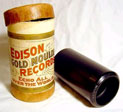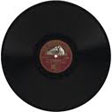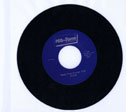Sound preservation at the Library of Congress
Currently, the Recorded Sound Collection at the Library of Congress numbers in excess of three million items and fills up 115,000 linear feet of vault space in the Library’s climate-controlled Packard Campus for Audio Visual Conservation in Culpeper, VA. Items date from the late 1880s to the present day and include everything from music to radio broadcasts to spoken word recordings to field recordings of traditional music, oral histories and actualities.
Each year, on average, the Library adds a further 75,000 sound items to its holdings via donations, acquisitions, and copyright deposits. Items arrive on a myriad of formats from cylinders to discs (78, 45, or 33 1/3) to reel-to-reel audio tapes to 8-tracks, cassettes, CDs, or even wire. Increasingly, new acquisitions arrive in digital forms.
Various sound formats at the Library of Congress |
||
A cylinder recording and its box |
A 78 rpm record |
A 45 rpm record |
All media types bring with them their own set of preservation issues: cylinders can break, albums can warp or wear out, and tapes can disintegrate. Even digital recordings can present a variety of playback issues. (For example, successive releases of software protrams may no longer be compatible with earlier files. Additionally, hard drives and serves crash.)
Examples of damaged media |
|
A mold-infested cylinder |
A delaminating lacquer disc |
Though some formats are more stable than others, the Library goes to variety of means to see to each item's endurance and longevity. In the case of a shattered cylinder, if the Library inherits all its pieces, technicians ce formats are more stable than others, the Library goes to a variety of means to see to each item’s enan carefully glue it back together. Worn out or heavily worn 78 platters can be played for maximum sound quality by experimenting with stylus sizes. Tapes affected with “sticky shed” syndrome (i.e. hydrolysis, a wearing away of the "glue" that holds magnetic particles to tape) can be baked at a low temperature, a process that reactivates their magnetic bindings. Almost all items require some degree of cleaning; the Library utilizes both solvents and vacuuming techniques to rid record grooves of dust and microscopic particles.
Preservation methods at the Library of Congress |
||
Records being examined |
A state-of-the-art audio workstation |
A Keith Monks cleaner |
Proper storage is the Library’s first line of defense against any loss or degradation to its holdings. All items are kept in one of the Library’s 17 temperature-controlled vaults, always set to 50 degrees Fahrenheit with 30% relative humidity. This cool, non-fluctuating environment helps retard a variety of preservation threats from breakage to warping to “delamination” to, in the worst cases, proliferation of mold.
Ideally, recordings of any vintage should be played as little as possible in order to maximize their lifespan. But, as is the mission of the Library of Congress, all items must be readily available to scholars and researchers. To see that recordings are able to endure but are also accessible, the Library of Congress is transferring its collection from their original formats to high-resolution digital audio broadcast WAV files (96 kHz/24 bit). These computer files can be digitally stored, are easily shared, and can be played endlessly without any fear of wear, tear or sonic loss.
Of course, to produce a digital file of any existing recorded disc (or cylinder or tape, etc.), the original item (its “source”) must be played fully and properly (i.e. uninterrupted and at the appropriate speed, etc.) at least once. Hence, the Recorded Sound Division of the Library of Congress maintains a cache of equipment capable of playing various “extinct” formats; while the majority of consumers have long since done away with turntables and cassette decks, the Library retains working set-ups of each, as well as devices capable of reading other obscure media.
The Library's equipment supply room |
The Library vaults |










